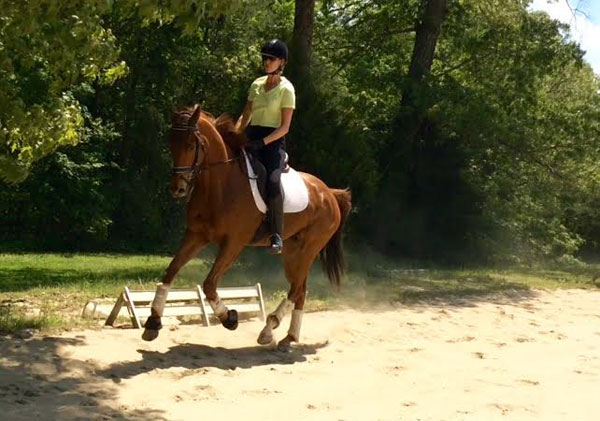You’ll pretty much always hear the BNTs (“big name trainers”) we all admire advising to “keep it playful” while bringing along a young horse. And most everyone knows that nothing kills a horse’s personality and desire for his job more than constant drilling in an arena, so keeping this in mind whilst also wanting to continue to build strength and balance, I’ve begun playing around with Forrest’s canter to keep dressage interesting to him.
Already introduced to small bursts of trot lengthenings, the last couple of weeks I’ve begun to ride Forrest forward and back in the canter as well. And, as always, pre-requisites have to be put into place in order to set my horse up for success. It was beaten into my head years ago that a lengthening is about ‘bounding.’ It’s not a flat, runny, gait where the horse stretches out his frame and bulldozes along on the forehand. Indeed, if you drew a series of arcs on a piece a paper, you would see that a horse that is lengthening would cover ground with a slight arc, a medium canter means a higher arc, and a great extended canter should look like McDonald’s Golden Arches: really buoyant, really bounding off the ground.
Since Forrest’s stronger hind leg is his right, I’m going to try, after our warm up, for a left canter lengthening today as his outside hind (the right) will be the loading leg and it will be physically easier for him. The first thing I want to do is make sure he is really on my aids, yielding in the ribcage from my inside, left, leg, and connected into my outside, right hand. To help achieve this, I pick up my left canter and spiral in and out of a 20 meter circle to about 13 meters–he’s just not advanced enough for anything smaller. This gives me quite a nice, balanced, canter.
Since spiraling out of a circle has gotten Forrest used to leg yielding at the canter, it’s no big deal, now, to turn down quarter line and simply leg yield to the rail.


I do this for two reasons: it’s a test that he is both obedient to my inside leg and comfortably moving into my outside rein and secondly, leg yielding helps a horse really use his inside hind leg as he has to step both deeper beneath the body and over. That will help set up his rear engine.

After riding a couple of canter leg yields, I come through the next short side while still riding that leg yielding ‘feeling’ and I now feel comfortable enough to taxi for take-off. I don’t want to shoot Forrest out of a cannon down the long side, I want to carefully build into the lengthening so that he doesn’t lose his rhythm or balance and fall on his face. I close both calves, sit deeply, and try to maintain my position, neither leaning back or forward, and away we go!


I get a really good effort, free of tension and in order to reward him and test that he’s still comfortably connected into the outside rein, I release my inside rein right at the end of the long side before throttling back to a working canter by simply sitting lighter,giving a couple of half halts on the outside rein, and offer a stretch as another reward:
I think this has been a good start and it’s important to remember to not ask for too much: I just want to ask for a few strides of forward and back. Asking for too many strides of lengthening risks not only Forrest losing his balance, but also his trust in me. But it’s fun to know that I can now mix up our work outs in all three gaits asking for ‘forward and back’- terrific for keeping his attention, strengthening him behind, and making it fun!












